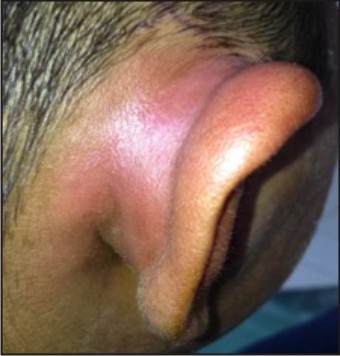Introduction
Chondritis is an inflammatory disease of connective tissue characterized by degradation of hyaline and elastic cartilage[1]. Close proximity of ear to TMJ makes it susceptible to injury during TMJ surgeries. Chondritis is an unusual complication of TMJ surgery, with very few cases reported in literature and those were generally associated with history of middle ear infection or chronic otitis[2]. Clinical features are painful swelling of external ear, tense helix, tenderness of auricle. Auricular chondritis in which auricle in part or total become shriveled is referred as cauliflower ear[3]. In present case, patient was recovering normally upto 7th day postoperative day following TMJ surgery. Incidence of swelling and tenderness of auricle , extending upto preauricular region was noted on 8th day .
Case Report
A 13 yr old female patient presented with reduced mouth opening and difficulty in eating food since 6 years. She had a history of fall 6yrs ago for which she never seeked any treatment, there was gradual reduction in mouth opening to 5mm. No history of previous ear infection, inflammation, TMJ surgery was given by patient.
On examination there was severe limitation of protrusive movement, lateral excursive movements especially on right side. There was flattening of body of mandible on left side and fullness on right side .OPG and CTscan revealed sawhney’s class III right TMJ ankylosis with prominent antegonial notch. Patient underwent gap arthroplasty and mouth opening of 35 mm was achieved intraoperatively. Patient was managed post operatively on regular regimen of IV antibiotics for 5 days and jaw exercises. At the time of discharge on 5th postoperative day, she had normal recovery. On 8th post operative day she came with cauliflower like ear of right side(Fig 1). Auricle was swollen, extremely tender, with swelling extending to preauricular region (Fig 2 & 3). Ultrasonography was done to rule out any foreign body and type of fluid in lesion. Prompt incision and drainage done 3mm anterior to pinna and the content was send for culture and sensitivity which revealed Pseudomonas aeruginosa as a causative organism and sensitive to Oflaxacin , Amikacin, Ciprofloxacin. Patient responded with the combination of ciprofloxacin and amikacin antibiotics given intravenously for 7 days (Fig 4). She was advised for strict compliance of jaw exercises and regular follow up visit. Post operatively at 3 months, a stable mouth opening of 31 mm was achieved.
 | Figure 1
 |
 | Figure 2
 |
 | Figure 3
 |
 | Figure 4
 |
Though, chondritis was managed successful, etiology of infection still remained mistery.
Case Discussion
TMJ surgery is widely performed via preauricular approach, various postoperative complications are associated with it[3]. Surgical access has to be designed in aesthetic fashion while preserving surrounding vital structures. Deep dissection at right angle of surface can lead to injury to anterior wall of meatus[4], making it prone to infection. Nearby infection of ear such as chronic suppurative otitis media increases risk of chondritis[5].
Chondritis is a rare complication after surgery of external ear[6]. Its onset is marked by diffuse red, painful swelling of auricle with or without fluctuation[7]. Patient usually report with marked painful swelling of auricle, reddish in colour, tenderness , tense helix. This infection may eventually lead to rapid destruction of cartilage and if not treated properly necrosis of cartilage will take place resulting in considerable morbidity and severe cosmetic deformity of ear.
Chondritis is a serious complication due to usual presence of antibiotic resistant organism pseudomonas aeruginosa, which is also cultured in chronic otitis media and externa[8]. It requires hospitalization and intravenous administration of antibiotics in addition to local treatment[9]. Early diagnosis and treatment minimizes the need for subsequent plastic surgery and reankylosis of TMJ.
Conclusion
Preauricular incision carries potential risk of chondritis by presence of nearby infection[3]. It is recommended to take detailed history of previous TMJ surgery, ear infection. If infection present then positively postpone the treatment until full recovery to avoid chondritis of auricular cartilage.
References
1. Michael A et al. “Auricular chondritis in rats- an experimental model of relapsing polychondritis”. The journal of experimental medicine. Volume 154,1981
2. Sanders B. “Arthroscopic surgery of temporomandibular joint: treatment of internal derangement with persistent closed lock”. Oral Surgery, oral Pathology, oral Radiology, and Endodontology, 62:361-372,1986
3. Ahmed A. Al-Zahrani. “A cauliflower ear: an unusual complication of TMJ surgery.” The Saudi dental journal, volume 5, number3, September 1993.
4. Rowe NL. “Ankylosis of temporomandibular joint”. Journal of royal college surg Edinburgh 27:27,1982.
5. Seraj AA, Zakzouk SM. “Diseases of ear, nose and throat”. Jeddah tihama, 31-32,1981.
6. BallengerJJ. “Disease of nose, throat and ear”. 12th ed. Philadelphia: lea and Febiger,779-80,1977
7. English GM. Otolaryngology. Maryland : Harper and row publisher,124-5,1979
8. Luckhaupt H, Rose KG. “Significant and problem of pseudomonas infection in ENT medicine”. HNO 33(12):551-3,1985
9. Noel SB, Scallan P. “Treatment of pseudomonas aeruginosa auricular perichondritis with oral ciprofloxacin”. J Dermatol surg oncol: Jun 15(6):633-7, 1989
|